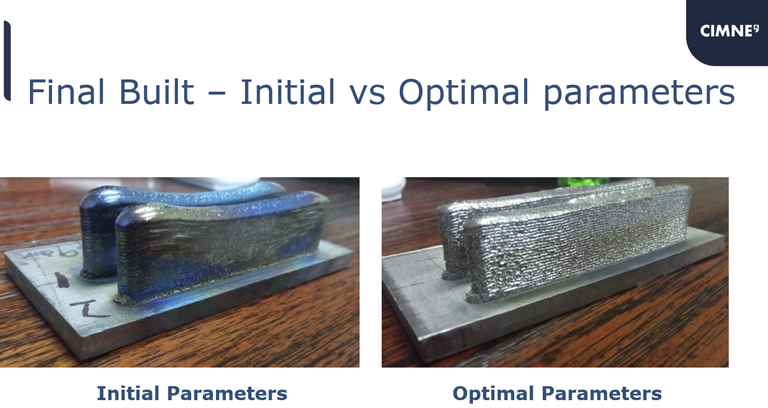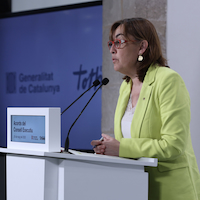news
[Interview] Carlos Moreira obtains a Juan de la Cierva Grant
 Carlos Moreira is a CIMNE researcher from Brazil. He holds a Master of Science in Structural Engineering with a focus on the development of nonlinear behaviour of cable-stayed bridges (2014) from the University of São Paulo and a PhD in Civil Engineering from the Technical University of Catalonia ("Finite Element Simulation of Additive Manufacturing (AM) with enhanced accuracy", 2022). Recently, Dr. Moreira was awarded a Juan de la Cierva grant to continue his research on simulation in industrial processes.
Carlos Moreira is a CIMNE researcher from Brazil. He holds a Master of Science in Structural Engineering with a focus on the development of nonlinear behaviour of cable-stayed bridges (2014) from the University of São Paulo and a PhD in Civil Engineering from the Technical University of Catalonia ("Finite Element Simulation of Additive Manufacturing (AM) with enhanced accuracy", 2022). Recently, Dr. Moreira was awarded a Juan de la Cierva grant to continue his research on simulation in industrial processes.
We invited him to talk to us about how he receives this recognition and what it means to him at this stage in his career. We also talk about his beginnings, inspirations and motivations.
-The research you do at CIMNE is focused on solving industrial engineering problems. What are the main challenges you are addressing?
The quality of Additive Manufacturing (AM) metal components is greatly dependent on the temperature history during fabrication. Various responses may result from process parameters, such as the printing pattern, power input, cooling pauses, etc. that may lead to quite different mechanical responses (warpage, residual stresses, microstructure). If those process parameters are not well defined, this may lead to very distorted components, high residual stress values, very anisotropic behaviour or even the overheating of the component during fabrication may cause the component to collapse due to the low bearing capabilities of the material at high temperatures.
The AM industry relies on trial-and-error experiments, which are time-consuming and expensive, to obtain process windows with minimum warpage, residual stresses, and a more homogeneous microstructure. In this sense, Computer-Aided Simulations can reduce those bottlenecks by providing accurate and reliable process windows at much lower expenses than experimental campaigns.

However, High-Fidelity (HF) simulations of the AM process require solving nonlinear equations several thousand times to obtain good accuracy, in very complex domains. HF simulation results may be achieved in two ways: 1) brute force, by using several thousand processors in High-Performance Computers (HPCs), and 2) through the development of numerical methods to speed up the solution of the system of equations.

We have managed to publish in the recent month the performance of our numerical framework in HPCs, presenting good scalability up to 2,048 processors. Therefore, we are currently able to use several thousand processors without losing relevant computational efficiency.
Our group is currently working on item (2) of the list to enable faster delivery of optimal process parameters to the industry at a lower computational cost without losing solution accuracy. This is a very challenging task due to the evolutionary nature of the AM problem, which is continuously changing the geometry of our domain and, consequently, the boundary conditions.
-There is a lot of talk about Additive Manufacturing...What stage of maturity do you think this technology is currently at?
The technology has the potential to reduce material waste, energy consumption and time-to-market for new developments, and the most attractive feature of AM is that it can build very complex designs. These are the reasons why several industries such as aerospace, automotive, biomedical and so on are investing in the field. This means that the industry sees a high potential for this technology to overcome traditional manufacturing processes, but this is not yet the case.
In my opinion, this technology is still in its early stages and there is a lot of potential for research in this area. To become a fully mature technology, we still need to understand the intricacies of the process parameters and their response. In addition, for AM technology to reach the mainstream manufacturing market, production capabilities need to be scaled. Increasing the scalability of manufacturing will allow more components to be produced at once, significantly reducing the acquisition cost of each part.
AM Technology is still in its early stages and there is a lot of potential for research in this area
-Why did you decide to go into research?
Undoubtedly my grandfather had a great influence on that. He always encouraged his grandchildren to ask questions, but never to give the answers; he wanted us to ask the right questions and discover the answers for ourselves. He had a very inventive mind and his house was full of gadgets that he designed to solve everyday problems. I think this stimulated my sense of curiosity, and at the end of the day, research is about trying to answer the right questions. This led me to do my Master's degree at the University of Sao Paulo, where I found great role models such as Prof. Paccola, Prof. Edson Leonel and my tutor Prof. Laier, and later to do my PhD at the UPC, where I was very fortunate to have Prof. Miguel Cervera and Prof. Michele Chiumenti as my tutors and to work with Prof. Joan Baiges, Prof. Ramon Codina, Prof. Manuel Caicedo and Prof. Gabriel Barbat.
-What does getting a Juan de la Cierva (JdC) grant mean to you?
The JdC grant is the first step after obtaining the PhD towards a scientific career path and is not only a personal achievement, but it was only possible together with the relevance of the research centre (CIMNE) and the research group (Industrial Manufacturing Processes). I feel very honoured that the research our group and I are carrying out received recognition in such a competitive environment. Thus, I want to thank, not only the Industrial Manufacturing Processes group, but also CIMNE which has a very high standard and commitment to quality research.




















